In the shadow of the majestic Alay Mountains and just a few kilometers from the Uzbek border, Osh might be best known for its sacred Sulayman Mountain or bustling bazaar. But for those who look beyond the usual tourist paths, this southern Kyrgyz city offers something rarer: a rich, fading tapestry of Soviet-era public art, architecture, and ideological remnants — waiting patiently to be discovered.
This walking tour through Osh reveals not only forgotten murals and mosaics, but also stories of labor, dreams of flight, and a space-age optimism rendered in concrete and ceramic. So lace up your boots and charge your camera—The Atlas Sovieticus is taking you on a journey into Soviet Central Asia, one artwork at a time.
Tour Overview
- Duration: Approximately 2-3 hours
- Distance: Around 6.5 km
- Highlights: 13 stops in total: Soviet monuments and murals
- Start & End Points: Victory Square to Osh Bazaar (closes at 5PM)
A Google Maps link for the whole tour and a downloadable GPX file are available at the bottom of this page!
1. Soviet War Memorial – Starting Point
(40°30’58.8″N 72°48’21.2″E)
Our tour begins with a humble yet poignant Soviet war memorial, located in a park near the Osh city square. A cut-out star, worn by decades of foot traffic and time, evokes the memory of those who fell in the Great Patriotic War. It’s a simple stone, yet it sets the tone: the Soviet Union’s presence in Osh wasn’t just ideological — it was lived, fought, and remembered. Explore the small park and you’ll also find a Chernobyl memorial – a nice addition to start the tour!
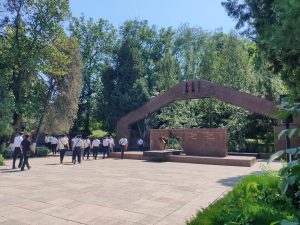
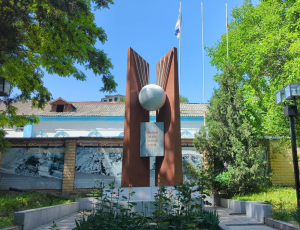
2. Lenin Statue
(40°31’03.2″N 72°48’20.6″E)
Just a few steps away stands the man himself. Towering and stern, Lenin gazes confidently into a future that never came to be. This statue was elevated in 1975 on a massive red stone pedestal, and has a total height of 30 metres – making it one of the largest in central Asia!
Some extra information about this statue: link

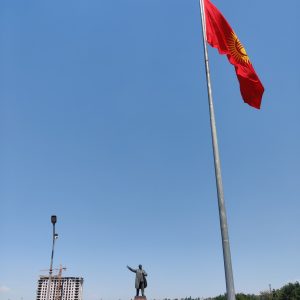
3. “Horse Power” Mosaic
(40°31’04.5″N 72°48’16.7″E)
Facing the Lenin statue is our first Soviet mosaic of the tour. At first glance, the mural’s busy colour palette may seem to blur its meaning — but look closer. A woman stands on the left, a man on the right, subtly symbolizing gender equality. The man can be seen riding a horse, a symbol of power and speed, highlighting its deep significance in Kyrgyz nomadic culture. The woman holds a white dove, a symbol of peace.
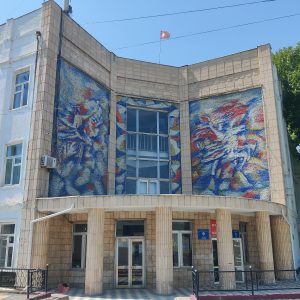
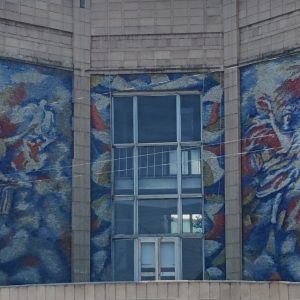
4. Drama Theater Mosaic
(40°31’11.5″N 72°48’05.8″E)
Continue along the avenue and you’ll soon meet the city’s Soviet-era drama theater. Its Southern side is our next stop: a cobalt blue-and-white mosaic. The featured figures —musicians, actors and poets – remind passersby of the USSR’s cultural mission: to uplift the masses through art. The contrast of blue tile against the Central Asian sun is breathtaking. It was completed in 1974. Be sure to take a quick look at main facade, which has an interesting stained glass window.
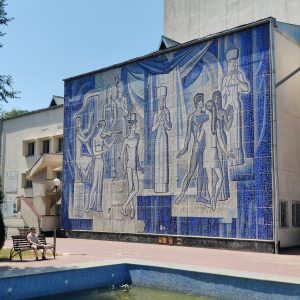
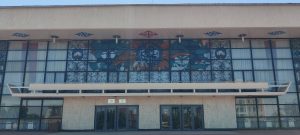
5. Sovet modernist hotel “Nuru”
(42°52’35.2″N 74°36’37.8″E)
Around the corner, a monolithic hotel looms like a Brutalist battleship. A relic of state-planned tourism and official delegations, its modernist lines and concrete slabs feel frozen in time. Peeking inside may reveal dusty chandeliers and faded wallpaper — Soviet chic, left to fade.
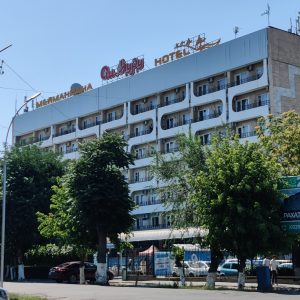
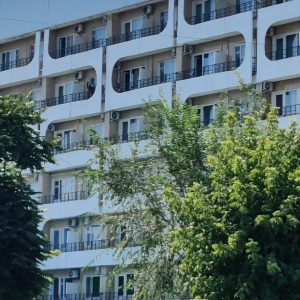
6. Dove Mural
(40°31’39.5″N 72°47’41.6″E)
Head right at the next crossing, following Kurmanjan-Datka St. Tucked along is a gentle surprise: a pastel-colored dove mural from the 1970’s. The white dove, covered in colorful decorative layers, was likely a Cold War-era emblem of peace — perhaps naive, yet sincere. It’s an unexpectedly tender moment amid the brutalist vibe of the tour.
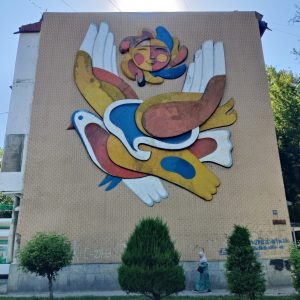
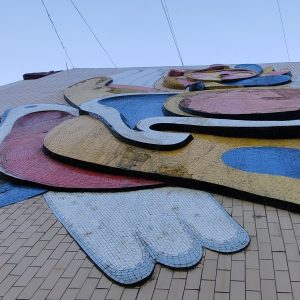
7. “Glory to Work” Sgraffito
(40°31’44.9″N 72°47’40.7″E)
Just a few meters ahead, two monumental sgraffito murals fill the walls. They display a series of workers in traditional Kyrgyz clothing. In the composition, of which all accents are painted in a blood-red coloring, we can see a man riding a horse, a woman holding a sickle and the slogan “Glory to work”. In the past it also included Lenin’s face, but I has been removed unfortunately!
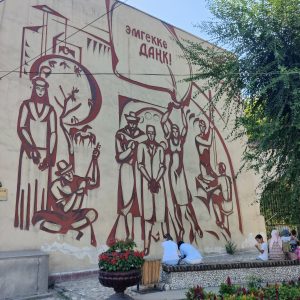
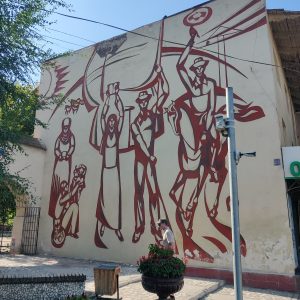
8. Osh State University & Park Route
(40°31’54.5″N 72°47’44.7″E)
Walk past the side of Osh State University, towards its stunning façade (an amazing example of Soviet-era architecture). The university was originally established by the Kirghiz SSR in 1939 as a teacher training institute and was upgraded to a comprehensive pedagogical institute in 1951.
Continue descending through the leafy Alisher Navai Park, and cross the river via the walkable underside of the bridge. You’re now heading towards the beating heart of Osh — the chaotic, colorful bazaar! But before you dive into the stalls, look up. Do you see an airplane mural?
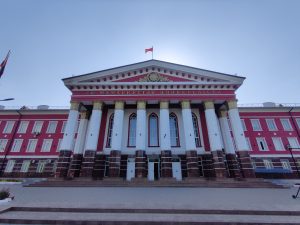
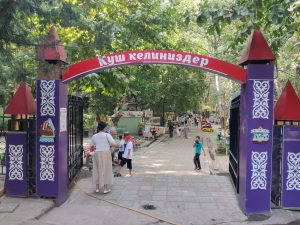
9. Airplane Sgraffito
(40°32’17.0″N 72°47’56.3″E)
High above the bazaar is a giant sgraffito mural that seems to float: a stylized airplane soaring through space. This could be Aeroflot propaganda or a celebration of Soviet aeronautics — it’s hard to say. But its scale is impressive, and its survival remarkable. You can reach it by weaving through the bazaar’s maze of corridors and staircases, which is a charming part of the adventure itself.
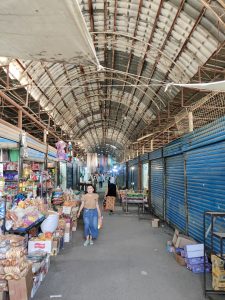
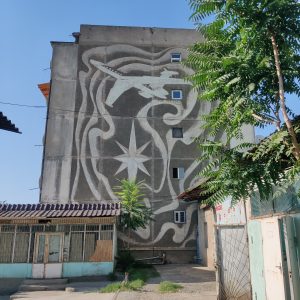
10. Worker & Wheat Mosaic
(40°32’13.3″N 72°48’03.2″E)
Cross the street and be rewarded with a riot of color. This large-scale mosaic features proud workers, golden wheat, and a palette of reds, oranges, and blues. It’s Soviet optimism in tile form, though the Hammer and Sickle emblem has been covered-up (“KT” sign).
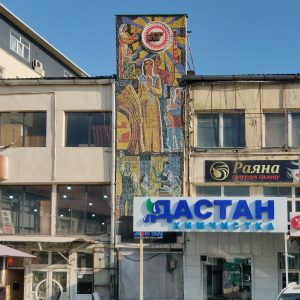
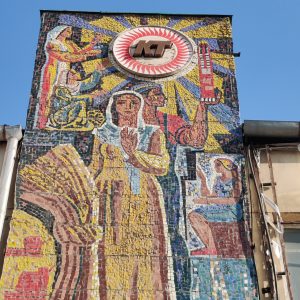
11. “Fabric” Mural
(40°32’02.5″N 72°48’15.8″E)
A few blocks onward, you’ll encounter a more subdued but no less beautiful mural celebrating the textile industry. A woman holds a red cloth, factories hum in the background, and the communist emblem is proudly held up. It’s another tribute to the importance of females and Soviet labour.
More details on this artwork can be found here: link
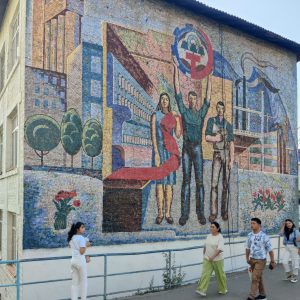
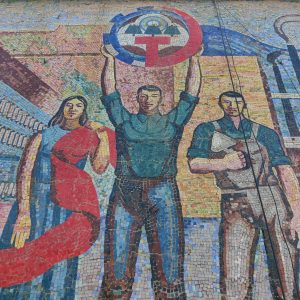
12. Mishka the Olympic Bear
(40°32’30.5″N 72°48’06.5″E)
As you follow Masalieva Street, keep your eyes peeled. On a large wall in a seemingly random side street, Mishka—the 1980 Moscow Olympics mascot- is smiling widely. Rarely seen today, this jolly bear feels like a time capsule of an era when even mascots carried political weight. The layered sgraffito has been recently repainted, a sign that local heritage is still being cared for.
More details on Mishka: link
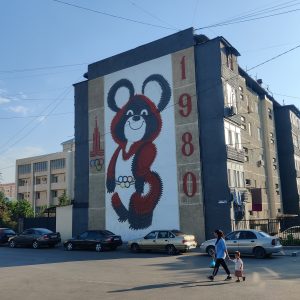

13. Vintage Aeroflot Advertisement
(40°32’33.2″N 72°48’05.0″E)
Near the Mishka mural is an old Aeroflot wall ad, surprisingly intact. Complete with Soviet-style fonts and cloud-like lines, it’s a rare example of Soviet-era commercial art. If you take a closer look at the Aeroflot logo, it still has a hammer an sickle featured!
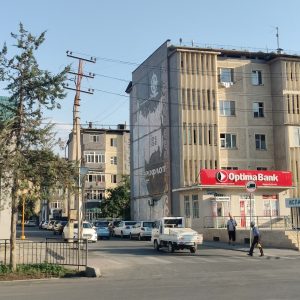
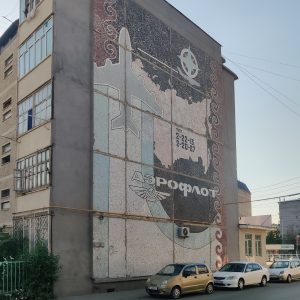
14. Cosmic Mosaics on School – End Point
(40°32’37.5″N 72°47’49.7″E)
We end our tour at a school whose walls are a love letter to the cosmos. Rockets, astronauts, satellites—all etched in shimmering tile. It’s a reminder of the USSR’s ultimate dream: to transcend Earth, and ideology, for the stars.


Route:
Final Thoughts
This walk through Osh is more than an art tour—it’s a conversation with history. The mosaics may be fading, the slogans may no longer inspire, but the ambition and artistry of the Soviet era remain etched into the city’s concrete skin.
So next time you’re in Osh, take this route. Follow the hammers and sickles, the cosmonauts and the Soviet workers. Discover a city where the past is tiled into the present — bold, bizarre, and very much alive.
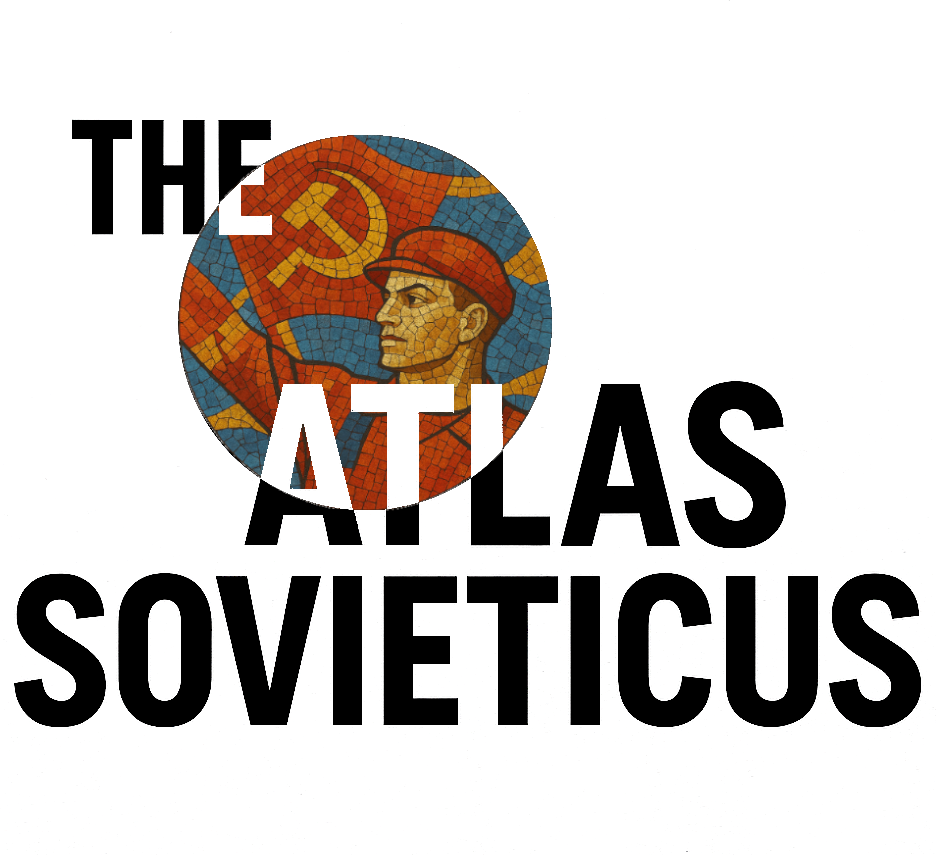




























Leave a Reply